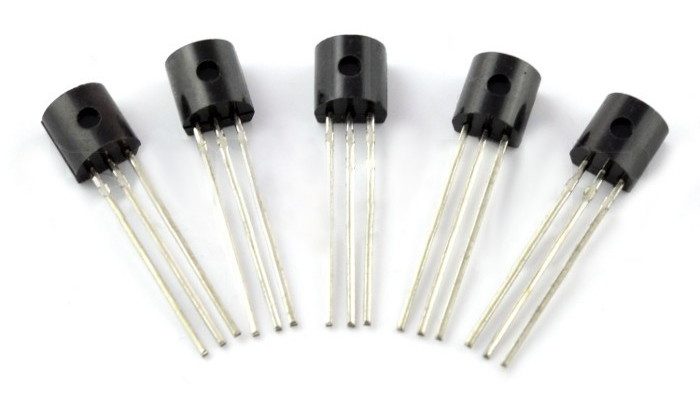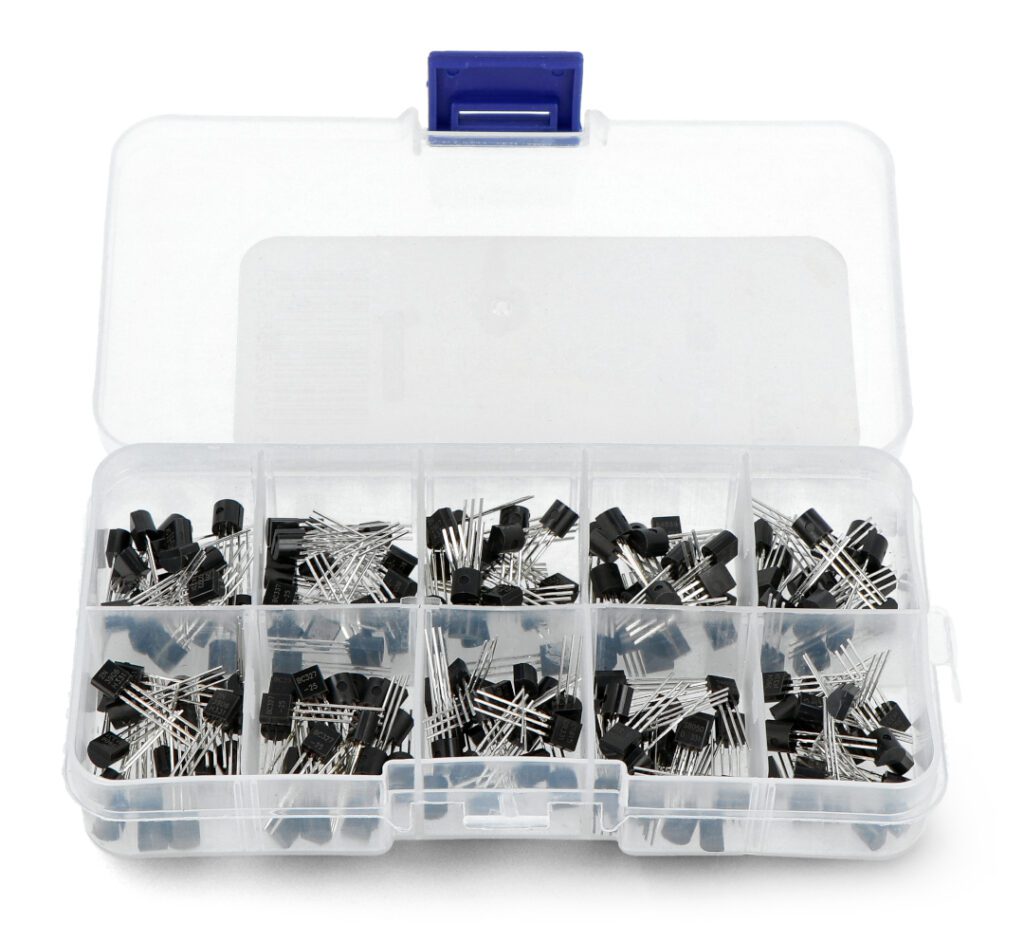Table of Contents:
The 2N3904 bipolar trans istor is one of the most popular and widely used NPN transistors.
In this article, we will look at the technical characteristics of this element and its example applications in electronics!
NPN transistor 2N3904 - characteristic parameters
The 2N3904 is a bipolar transistor with an NPN conduction type – this means that current flows from the emitter to the collector when a suitable threshold voltage is applied to the base.
It is a low-power transistor, but has a relatively high current amplification factor (hFE), which usually ranges from tens to hundreds.
The allowable collector-emitter voltage (Vceo) is about 40V, which means that the 2N3904 transistor can switch voltages of this level.
Similarly, the allowable collector-base voltage (Vcb) is also about 40V.
In contrast, the maximum emitter-base voltage (Veb) is about 6V.
The 2N3904 transistor can conduct a continuous collector current (Ic) of up to 200mA.
The base current (Ib) is proportional to the collector current and is determined by the current gain factor.
The 2N3904 is available in various housings, such as TO-92 (THT mounting), SOT-23 (SMD mounting) and others.
Applications of the 2N3904 transistor in electronics
Although the 2N3904 transistor is a low-power signal component, its applications are wide and include.
low-power amplifiers, electronic switches, detectors, voltage regulators, electronic protection, as well as noise generators.
When designing electronic circuits with transistors, it is important to become familiar with the exact parameters available in datasheets, including electrical parameters, current and voltage characteristics, and frequency characteristics.
The 2N3904 transistor is often used because of its versatility, availability, low purchase cost and good electrical performance, making it a popular choice for many electronic applications.
Testing a bipolar transistor
To test an NPN-type bipolar transistor with a multimeter, you can use the diode test mode of the multimeter.
Turn off the power to the circuit under test and make sure the transistor is disconnected from any live power circuit.
Set the multimeter to diode test mode and identify the connectors of the transistor.
An NPN transistor has three junctions: emitter (E), base
(B) and collector
(C).
The multimeter used here so that it can measure the voltage at any two connectors of the transistor.
In diode mode, the multimeter supplies the transistor with a small voltage and helps identify the diodes embedded in the transistor.
We connect the red probe of the multimeter to the base (B) of the transistor.
Holding the black probe, check the connection between the base (B) and emitter (E).
The voltage will drop on the ,,diode” base-emitter.
Then, holding the red probe on the base of the transistor, we apply the black probe to the collector.
At the base-collector junction, the voltage drop should also be similar to that at the base-emitter junction, checked in an identical manner.
Switching and control with 2N3904 transistor
The NPN bipolar transistor, like the 2N3904, can be used in various circuits, including frequency filters.
In a high-pass and low-pass filter, NPN 2N3904 transistors can be used as operational amplifiers to provide appropriate signal gain in specific frequency bands.
The 2N3904 can be used in an operational amplifier configuration to amplify the input signal before passing it through filter elements such as capacitors and inductors.
The NPN transistor can be used as an amplifying element in a band-pass filter.
In this case, the 2N3904 can be used as part of an amplifier configuration that amplifies the signal in the frequency band to be passed through the filter.
In a low-pass filter with an active element, the NPN transistor can be used as part of a low-pass filter circuit in which the signal is passed through a capacitor and resistor.
The 2N3904 can be used as an operational amplifier in an integrating (integrator) or differentiating configuration, which are often used in this type of filter.
In low-pass filters with an inductor, the NPN transistor can be used as a signal amplification element before passing it through the inductor and capacitor.
The 2N3904 can be used as part of an operational amplifier or in an emitter or collector common-circuit configuration to amplify the signal.
All of these applications require appropriate circuit design based on the properties of the 2N3904 transistor and frequency filtering requirements.
The NPN transistor can be used as an amplifier, a key or a regulating element in frequency filters depending on the needs of the project.
2N3906 - complementary pair for 2N3904
The complementary pair for the 2N3904, is the PNP transistor 2N3906.
This means that they are PNP (2N3906) and NPN (2N3904) bipolar transistors, which have similar characteristics, but with opposite types of conductivity:
- The 2N3904 (NPN) has the emitter connected to the positive supply and the collector to the load.
- The 2N3906 (PNP) has the emitter connected to the negative supply and the collector to the load.
This means that the 2N3904 (NPN) transistor is designed to work in circuits where current flows from the emitter to the collector (e.g., from negative supply to load), while the 2N3906 (PNP) transistor is designed to work in circuits where current flows from the collector to the emitter (e.g., from positive supply to load).
As a result, the 2N3904 and 2N3906 can be used as complementary pairs in a variety of electronic applications , such as amplifiers, switching circuits, and voltage stabilizers.
This makes it possible to design integrated circuits in transistor circuits, providing the opposite type of conductivity for different parts of the circuit.
How useful was this post?
Click on a star to rate it!
Average rating 5 / 5. Vote count: 3
No votes so far! Be the first to rate this post.





















